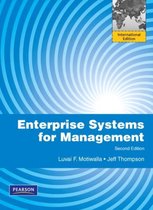Samenvatting
Summary Enterprise Systems For Management, ISBN: 9780132570169 Business Information Systems Management (1BV20)
- Instelling
- Technische Universiteit Eindhoven (TUE)
Summary of the lecture notes, slides, and relevant course materials for the course 1BV20 in the academic year 2020/2021.
[Meer zien]





